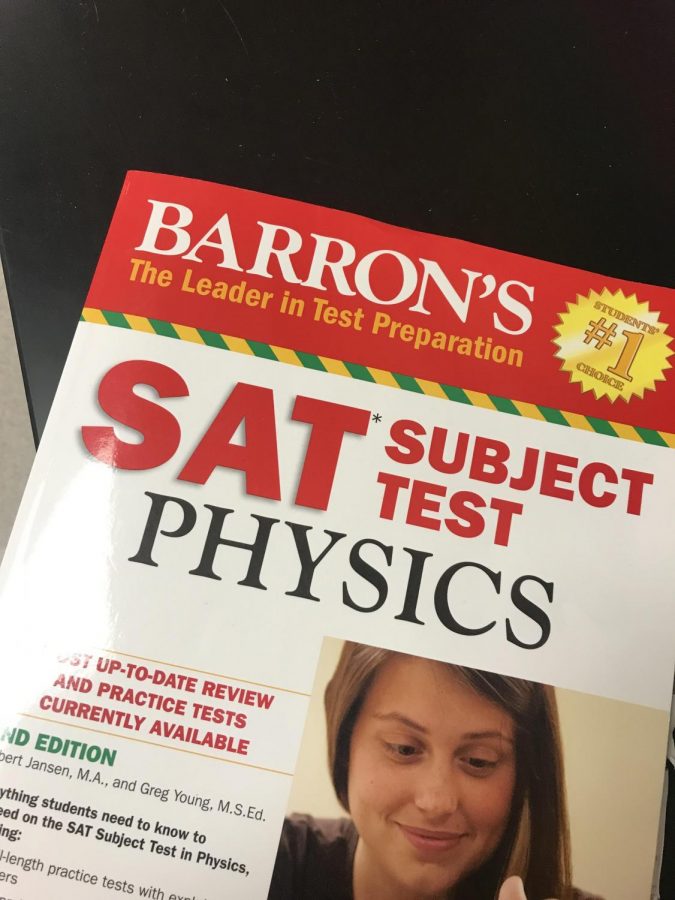Stats against the SAT
May 23, 2021
I walk into the cafeteria and glance around looking for the shortest lunch line. After a few seconds I make my choice and wander over to the shake line.
The line moves fast and after a few moments I have a strawberry milkshake in one hand and a piece of cake in the other.
Happily, I stride over to my table. When I sit down I intercept a conversation between my friends. “The donut line was so long today, I get that it’s the best line but geez who eats them every day?” one of my friends complains.
“I know right! I always go to the candy line instead.” Everyone at the table nods in agreement before turning to their food.
The cafeteria would never be able to serve only junk food. Parents would argue about the health of their children, administrators would get in trouble with the health department, and students would get sick.
Important decisions for students are guided by science. Schools don’t exclusively serve donuts at lunch because studies show that donuts are unhealthy. Schools encourage sports because studies show that exercise is healthy.
So why do schools, the College Board, and admissions offices get away with ignoring scientific data related to the SAT?
Ironically, the test intended to evaluate a student’s intelligence blatantly ignores basic facts.
Lack of Sleep
There is no reason the SAT needs to start at 7:45 am. Research has consistently shown that high school students perform better if they get the recommended eight to ten hours of sleep.
In fact, one study conducted by the University of Washington and the Salk Institute for Biological Studies showed that moving school start times an hour later resulted in more sleep for students, decreased tardiness, and an average 4.5% increase in grades.
A 4.5% increase in grades just from allowing students to sleep?! Shifting the SAT’s start time is an obvious opportunity, yet schools and the College Board continue to disregard the facts.
The University of Washington is not the first and will not be the last to show these results, so why do schools force students to take such an important test so early?
Logistically, a shift in start time would be easy. Test day is already a half day, so moving the SAT to the second part of the day would be a minimal change that would allow students to get more sleep and eat lunch before the test.
Changing the test’s start time would also have zero effect on sports, clubs, and other after-school activities, since students would get released at the normal dismissal time.
The change would also minimally affect transportation. Buses already have to be available to drop off students around noon. With the shift, they would just do the opposite, pick up at noon and drop off at three.
When it comes to start time, the College Board and schools blatantly ignore clear research.
Short Breaks
In addition to shifting start times, The College Board should offer larger breaks after each section.
During the test, students complete four sections plus an essay. A total of four grueling hours worth of testing, with a measly 20 minutes of break total.
One ten-minute break after the first section. One five-minute break after the third section. And one-five minute break before the essay.
A study conducted using DeskTime, a time management and productivity app showed that most productive people in the study followed the 52-17 rule. They would work for 52 minutes and then break for 17 minutes.
The break allows them to fully recharge and prepare for the next block of work they need to complete. If the SAT followed this model, students should get four times the break they have now.
Despite blatant research, the SAT, a long test with tiny breaks, is somehow still considered an accurate measurement of a student’s knowledge.
It is absolutely ridiculous to expect students to go to the bathroom, get a snack, drink water, and refocus in five minutes.
Students can barely walk to the bathroom and back in five minutes, let alone fully recharge and prepare for the next section.
When a cashier is released to their break they don’t walk to the break room, go to the bathroom, and walk right back out, ready to go. That expectation would be absurd; however, those who organize the SAT clearly lack common sense.
There is no surprise that students have trouble focusing during the SAT. Not only is the test long, but the breaks are comically short.
Test Pressure
On top of being tired and overworked during the SAT, many students struggle with genuine test anxiety. In fact some studies estimate around 16% of high school and college students have test anxiety.
Test anxiety cripples students. For many, the SAT is the key to admission into their dream school, a scholarship they desperately need, a better life. Dreams they will struggle to reach because of anxiety.
We don’t tell people who have allergies to “suck it up”. We don’t pretend that the flu doesn’t exist. So when will we finally accommodate for mental illness?
Many students prepare long and hard for the SAT. They spend hours on Khan Academy, practice tests, and YouTube. The SAT may be their last shot at their dream. But as soon as they receive the test panic sets in.
Symptoms of severe test anxiety include excessive sweating, nausea, vomiting, diarrhea, stomach pain, rapid heartbeat, shortness of breath, headaches, fainting.
How can anyone possibly take a life-changing test while dealing with all those symptoms? And why do college admissions offices still rely so heavily on a fluke test.
For those who have severe test anxiety, the SAT is a nightmare, a nightmare that affects every aspect of the college admission process and the future of many students.
Overall, the SAT judges a student’s intelligence through a method that ignores clear science. That is simply not… intelligent.




